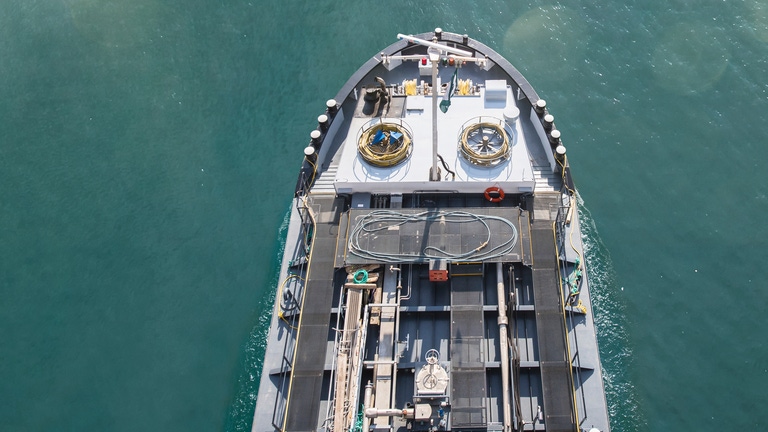Inland navigation vessels
When the proverbial “six inches of water under the keel” is in danger of becoming five or even less, the BASF site at Ludwigshafen is faced with many special challenges. Inland navigation vessels play a significant role when it comes to supplying the Ludwigshafen site with raw materials. For example, an average of 12 inland vessels dock at the BASF harbors each day, with around three-quarters of this number loaded with raw materials. The inland vessels also link the Ludwigshafen site with the international ports of Amsterdam, Rotterdam and Antwerp, together known as ARA. “The Ludwigshafen site uses the level of the Rhine at Kaub as a marker. This part of the river with its rocky bed is the shallowest part of the Rhine which a ship must navigate between the North Sea and the Upper Rhine,” said Dieter Mehrle from Barging Services Europe. If the water level relevant for shipping drops below 160 cm at this point, the Rhine has a low water level. For inland shipping, this means that the load must be reduced. Depending on how low the water level is, the same load capacity may require more ships, which is a challenging situation for both the shipping companies and the BASF loading coordinators. At the time of the lowest water level in November 2018, only ships suitable for very low water levels were capable of reaching the BASF harbors, as Mehrle explained.
Railway logistics
When inland vessels are forced to reduce their loads, the first alternative option is rail transport. This is a great challenge for the BASF railway logistics unit, as the free market reacts very quickly to changes due to low water levels – meaning the transport capacities and tank cars are not as readily available. In 2018, BASF also carried out planned and unplanned factory updates, which required additional amounts of raw materials to be transported by rail. From October 2018, the railway logistics team and all the affected parties held daily telephone conferences to discuss which raw materials were to be transported to Ludwigshafen by rail. The challenge in situations like these is to deploy the scarce resources as they are required in order to uphold the value chains at the site. This includes providing enough tank cars, the on-site transportation to the loading stations and external transportation.
“These were intense months, as the low water level lasted for an unexpectedly long time. We had to make significant cuts and tank cars had to be assigned in the Verbund coordination group. Without the motivation and close collaboration of the BASF teams, it would not have been possible to manage these challenges,” said Peter Rösner (FPO/EE) and Gerd Fischer (ESL/RL) proudly. “From the physical and administrative logistics units to freight procurement in close collaboration with the business units, everyone involved achieved great things.”
Truck - and Intermodal Transport
When taking a glance at the truck and intermodal transport options, it becomes apparent that all transport carriers are equally important for supplying the site in the case of natural events, such as the low water level.
Even if trucks play a subordinate role when it comes to supplying the site with raw materials – in contrast to their significance in sales logistics – this transport method played an important role in overcoming the issues caused by the low water level in 2018. For instance, from mid-October, the employees from the Transport Management Surface Bulk Europe team (G-FPO/ETE) controlled over 65 rented tank containers, which were used to continuously supply the site via road and combined transport. “Overland transport is highly flexible and can quickly adjust to changing situations,” says team leader Dirk Wagner (G-FPO/ETE). This meant that the internal truck logistics experts were important partners to the supply planners during the period of low water. “Many colleagues recognized that our transport volume of around 8,000 metric tons made a significant contribution to supplying the site, something we are very proud of,” said Wagner.
